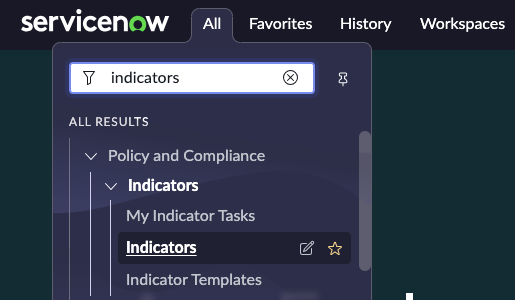To create a new Control Indicator in ServiceNow, go to:
All > Policy and Compliance > Indicators > Indicators

Here’s the list view of Control Indicators:

All > Risk > Indicators > Indicators or
Audit > Indicators > Indicators
Key Control Indicators (KCIs) play a crucial role in risk management by providing organizations with a proactive and systematic approach to monitoring and assessing the effectiveness of their internal controls. The importance of KCIs can be summarized in several key points:
Early Warning Signs:
KCIs act as early warning signs by identifying potential issues or weaknesses in internal controls before they escalate into more significant problems. Monitoring these indicators allows organizations to take corrective action promptly.
Risk Mitigation:
KCIs help organizations identify and address risks before they negatively impact operations, finances, or reputation. By continuously monitoring key controls, organizations can implement measures to mitigate potential risks and prevent adverse outcomes.
Compliance Assurance:
Monitoring KCIs is essential for ensuring compliance with regulatory requirements, industry standards, and internal policies. It provides evidence of an organization’s commitment to maintaining a robust control environment, which is crucial for regulatory audits and assessments.
Operational Efficiency:
By regularly assessing key controls, organizations can identify opportunities for improving operational efficiency. This may involve streamlining processes, enhancing automation, or optimizing resource allocation to better align with business objectives.
Fraud Prevention:
KCIs contribute to fraud prevention by helping organizations detect unusual patterns or anomalies in activities. Monitoring key controls related to access, segregation of duties, and financial transactions can aid in identifying potential fraudulent behavior.
Strategic Decision-Making:
The data gathered from KCIs provides valuable insights for strategic decision-making. By understanding the performance of key controls, management can make informed decisions about resource allocation, risk tolerance, and overall business strategy.
Continuous Improvement:
Regular monitoring of KCIs supports a culture of continuous improvement. Organizations can use the insights gained from KCI assessments to refine and strengthen their internal controls, adapting them to changing business environments and emerging risks.
Stakeholder Confidence:
Effective control environments, as demonstrated through the monitoring of KCIs, enhance stakeholder confidence. Whether it’s investors, customers, or business partners, stakeholders are more likely to trust organizations that actively manage and monitor their risks through robust internal controls.
Cost Management:
By identifying and addressing control deficiencies early on, organizations can potentially reduce the costs associated with remediation efforts, legal issues, and financial losses that may result from control failures.
Integrated Risk Management:
KCIs play a key role in integrated risk management, aligning risk management practices with overall business objectives. This integration ensures that risk management is not a standalone function but an integral part of the organization’s governance and decision-making processes.
In summary, KCIs are essential tools that empower organizations to proactively manage risks, enhance operational efficiency, and build a resilient control environment. They support compliance efforts, help prevent fraud, and contribute to the overall success and sustainability of the organization.



